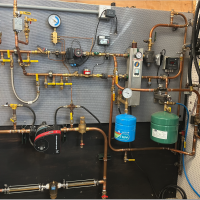How does water velocity affect a hydronic system? This weeks video

While we focus on gallons per minute and feet of head, improper water velocity in a hydronic system can cause uncomfortable areas, air accumulation, and erosion of the metal causing leaks. Hope you enjoy the video
Boiler Lessons
Comments
-
thanks you
0 -
High velocity does not decrease heat transfer at the heat emitter. If there is a differential between the heat emitter and the space, heat will flow. Many seem to think that at some arbitrary velocity the btu's become afraid to jump off of the bus which is not so. In fact, at higher velocities or said differently, smaller differentials the average temperature across the heat emitter is slightly higher which leads to more output. Number 30 Slantfin gives off 540 buts/ft at 170f and 610 btu/ft at 180f. 4gpm at a 20 degree differential and 8gpm at a 10 degree differential would both deliver 40 mbtu's. I am not advocating for 8gpm through 3/4 baseboard, As Ray stated, velocities over 4fps can be problematic.
1 -
Always different opinion. Fast moving water has no problem releasing the heat energy. In any type of heat emitter. The limitation is usually flow velocity through the piping. It's hard to rationalize slow moving fluid not transferring heat, and also fast moving water not transferring heat.
500 X flow X ∆T
I've been to a number of Robert Bean seminars. he has mentioned velocity up to 5 fps. Above that you start to hear the water.
Piping over 2" is sized by pressure drop, not velocity. As you mentioned 8 even 10 fps is not uncommon in larger pipes.
Nice presentation, you have a DJs voice :)
Bob "hot rod" Rohr
trainer for Caleffi NA
Living the hydronic dream0 -
Thanks @Peregrine
@hot_rod and @Tim_D I would normally agree with you I had an apartment building with zone valves for each apartment They had huge 3/4 hp pump I got called there When I arrived only one zone was calling The owner turned the boiler temp up to 200 degrees There was little heat coming from the baseboard I partially closed the ball valve until there was a 20 degree delta t As soon as I did that the baseboard started heating Weirdest thing I ever saw.
@hot_rod Dj lol my kids would disagree Thanks
Ray Wohlfarth
Boiler Lessons0 -
200 SWT, 1 delta= 199.5 AWT with SlantFin #30 that is 710 btu/ft
200 SWT 20 delta= 640 btu/ft
Maybe the heat from choking down the flow from a 3/4 hp circ, to 2 gpm? running it off its curve, cavitating?, to one zone warmed it up more😯
Bob "hot rod" Rohr
trainer for Caleffi NA
Living the hydronic dream0 -
@hot_rod Not sure what it was. The owner and the tenant kept asking When is the heat coming on. The delta t for the zone was 2 degrees F before adjusting the valve. It was a strange service call
Ray Wohlfarth
Boiler Lessons0 -
I would have liked to see pressure gauges on each side of the pumps to see the actual pressure drops vs. calculated.
TACO 007’s are such a “gentle” pump; hard to image them over pumping.
With all our knowledge, there are many weird things that happen on jobs that confound us and are beyond explanation.8.33 lbs./gal. x 60 min./hr. x 20°ΔT = 10,000 BTU's/hour
Two btu per sq ft for degree difference for a slab1 -
@Alan (California Radiant) Forbes Thats what I love about this industry is that I learn something new every day sometimes in a humbling way.
Ray Wohlfarth
Boiler Lessons1 -
Precisely what we experienced in development of our Delta-T Distribution managed "Neo-Gravity Hydronic Heating Appliance™". A decade in development with over 750,000 hours operation of our Betas indicates that the application of set-point circulators needs revisiting.
Concurrently the Hydrolevel 3250+ Algorithm needs refinement as well to closer emulate natural gravity convection for optimized performance.
BoilersOnDemand.com
0 -
-
This can happen in gravity-converted systems as well. The large pipes have little resistance which was needed for gravity circulation, since the motive force was so small in these systems. Over-pumping such a system can cause the water to short-circuit through the radiators, which leaves them partially cold.
Here's how I discovered this, many years ago (note- we replaced that old Spencer a few years after I wrote this):
and here is my guide to circ sizing, which resulted from some subsequent research:
All Steamed Up, Inc.
Towson, MD, USA
Steam, Vapor & Hot-Water Heating Specialists
Oil & Gas Burner Service
Consulting0 -
Some testing I did with cast iron radiators at flow rates from . 3 gpm up to a 8 gpm.
Two measured observations, the faster the flow in gpm, the hotter the radiator would get and in a shorter period of time.
With both supply and return at the bottom of this radiator one would think flow would short circuit, especially at a presumed over-pumped condition of 8 gpm. Yet the thermocline is powerful enough for the top of the radiator to warm at that 8 gpm flow.
The same observation with this large L shaped radiator with bottom S&R. The L shape radiator was flowing around 1.5 gpm with 1/2" TRV, interesting that the top runs warmer, but overall temperature is lower.
The measured output, confirmed by both a certified BTU meter matches closely to what the hydronic formula 500 X flow X ∆T predicts.
You find this same data in fin tube manufacturers, air handler, and radiant circuit design and output. Tighter ∆ results in higher average temperature across the heat emitter which = higher output.
Perhaps there are boiler designs out there from years gone by that do not exchange heat at higher flow rates? Even a pot of water on a burner warm faster if you stir it, from my experience?
Bob "hot rod" Rohr
trainer for Caleffi NA
Living the hydronic dream1 -
It's usually more pronounced when the rad is piped top and bottom on the same end. In many cases, you don't need a FLIR- you can feel the short-circuiting flow pattern with your hands- the rad is hot on the end where the pipes are connected, but cooler on the other end.
All Steamed Up, Inc.
Towson, MD, USA
Steam, Vapor & Hot-Water Heating Specialists
Oil & Gas Burner Service
Consulting0 -
what is the most common way to pipe a hydronic radiator? I would guess across top to bottom?
Bob "hot rod" Rohr
trainer for Caleffi NA
Living the hydronic dream0 -
The other issue is the way the rads and associated piping were installed in gravity systems.
For example, the Italian Flue rad that is placed on the dolly looks like it's rated 56 square feet EDR. In a gravity system if that rad is on the first floor, it might be piped with 1-1/4" pipe. On the second floor, it might be 1" pipe. The difference helps to even out the flow between floors, since warm water will naturally rise to the top of the system first. The system in my own house is piped this way. Other times, they took the upper floor runouts off the side of the mains and the lower floor runouts off the top, so the lower floor would get hotter water.
The Rococo Corner rad looks like 110 square feet. In the same system it might be piped with 1-1/2" on the first floor and 1-1/4" on the second, for the same reason.
Rad ratings are here:
With such large pipe sizes relative to EDR, the velocity of the water entering the rad is very low. Therefore, since water is lazy, it will find the shortest "path of least resistance" thru the rad, which is the shortest path between the flow and return connections.
Why didn't you get the same result? Well, it looks like you piped your rads with 1/2" pipe (or maybe 3/4", but it looks like 1/2" to me). At the higher GPM rates, the entering velocity is much higher than in a gravity-designed system. This higher velocity acts like a jet pump, which draws cooler water up or down the first couple sections (depending on whether the supply is top or bottom) and allows hotter water to take its place. This internal circulation allows the rad to heat evenly despite the higher GPM.
Try this: Remove the additional bushings from both rads that you used to get the original openings down to 1/2" (or 3/4"). Pipe out from these original openings full size to 4-5 feet or so from the rad, then reduce them. Run the test again and get back to us.
All Steamed Up, Inc.
Towson, MD, USA
Steam, Vapor & Hot-Water Heating Specialists
Oil & Gas Burner Service
Consulting0 -
Try this: Remove the additional bushings from both rads that you used to get the original openings down to 1/2" (or 3/4"). Pipe out from these original openings full size to 4-5 feet or so from the rad, then reduce them. Run the test again and get back to us.
The test was done with 1" S&R. 1" rubber hose 1" ID. I'll see if I can get both ends back to 2". I used 1" for the 8 gpm test to keep velocity in the acceptable range, @ 3 fps.
It looks, by the original decorative bushing, that it was piped with 1" in the building Steve Minnich removed it from, in Chicago.
Sadly I had to leave the corner rad behind in Missouri. It was connected and operation in our home, so it had to stay when we sold. It was 1/2" S&R running 120 SWT
Bob "hot rod" Rohr
trainer for Caleffi NA
Living the hydronic dream0 -
Did the hose have barbed or other fittings with reduced inside diameter?
All Steamed Up, Inc.
Towson, MD, USA
Steam, Vapor & Hot-Water Heating Specialists
Oil & Gas Burner Service
Consulting0 -
barb by male adapters. The hole at the male thread end is the same as the barb end, like any make X adapter
Both ends are now 2”, adapters ordered to supply and return with 2” pipe
It is wide open from one end to the other
Bob "hot rod" Rohr
trainer for Caleffi NA
Living the hydronic dream0 -
Flow testing as per Steamheads suggestions. Radiator is wide open across bottom, 1-1/4" copper tube will slide thru.
I will switch pumps, see if I can get around 20 gpm.
Bob "hot rod" Rohr
trainer for Caleffi NA
Living the hydronic dream0 -
Notice that it took over 20 minutes for the rad to heat up to a consistent temperature all the way through, and that the first section gets little warm water until then. Try going down to 1 GPM or so. You're looking for the warmer water to rise to the top the second it arrives in the rad, which displaces the cooler water downward. This is the circulation pattern we see in systems that are still running on gravity.
All Steamed Up, Inc.
Towson, MD, USA
Steam, Vapor & Hot-Water Heating Specialists
Oil & Gas Burner Service
Consulting0
Categories
- All Categories
- 87.3K THE MAIN WALL
- 3.2K A-C, Heat Pumps & Refrigeration
- 61 Biomass
- 427 Carbon Monoxide Awareness
- 119 Chimneys & Flues
- 2.1K Domestic Hot Water
- 5.8K Gas Heating
- 114 Geothermal
- 165 Indoor-Air Quality
- 3.7K Oil Heating
- 76 Pipe Deterioration
- 1K Plumbing
- 6.5K Radiant Heating
- 395 Solar
- 15.6K Strictly Steam
- 3.4K Thermostats and Controls
- 56 Water Quality
- 51 Industry Classes
- 50 Job Opportunities
- 18 Recall Announcements
















